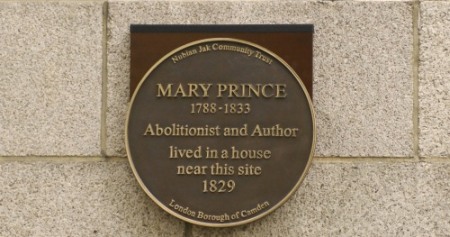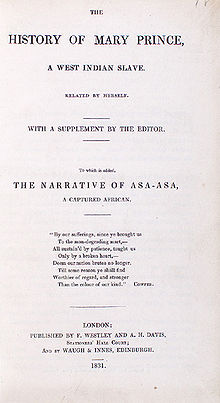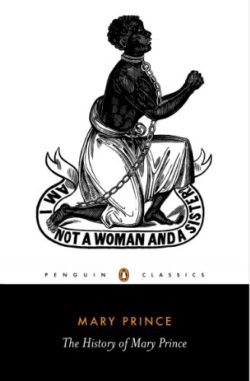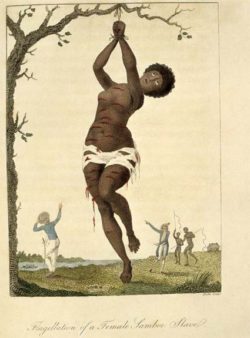 I’m always on the lookout for guided walks where I’ll be shown sites and hear histories not in the Establishment’s textbooks. Black History Walks showed me this plaque located in Bloomsbury on a wall where passerbys are unlikely to notice it.
I’m always on the lookout for guided walks where I’ll be shown sites and hear histories not in the Establishment’s textbooks. Black History Walks showed me this plaque located in Bloomsbury on a wall where passerbys are unlikely to notice it.
 Mary Prince was a slave born in Bermuda about 1788. Sold to several masters on different islands, she was brought to England in 1828 and a few years later dictated her story for publication. She was a migrant woman. You can read about Prince on many websites, one of which marvellously refers to Mary Prince’s Journeys.
Mary Prince was a slave born in Bermuda about 1788. Sold to several masters on different islands, she was brought to England in 1828 and a few years later dictated her story for publication. She was a migrant woman. You can read about Prince on many websites, one of which marvellously refers to Mary Prince’s Journeys.
 The original 1831 edition of The History of Mary Prince had what we’d now call a title page as cover, according to the British Library. Later editions used and continue to use images, however.
The original 1831 edition of The History of Mary Prince had what we’d now call a title page as cover, according to the British Library. Later editions used and continue to use images, however.
Victimising imagery is standard fare in anti-trafficking campaigning as it is in most Third-World ‘Aid’ advertising. The theory is that feeling their heart-strings tugged loosens viewers’ holds on their wallets. The most-used images show girls cowering, hiding their faces, chained in dark places, crying. I collected a lot of the more horrible ones in an album. The victimisation of migrating women was my earliest question and complaint about how the mainstream was talking about them, and I published Forget Victimisation in 2003. (If you go to this link note the photo I used there.)
There are no photos of Prince from her lifetime, so what are the pictures used on covers of later editions of the book?
 Penguin Books presently use this: a recognisable icon of anti-slavery history – the original Abolitionism. Slave is made to equal pitiable helpless shackled person in a pleading position. Pleading for help, for someone outside herself to free her. It’s a particularly inappropriate image to use for Mary Prince, whose agency can be in no doubt. Penguin should stop using it.
Penguin Books presently use this: a recognisable icon of anti-slavery history – the original Abolitionism. Slave is made to equal pitiable helpless shackled person in a pleading position. Pleading for help, for someone outside herself to free her. It’s a particularly inappropriate image to use for Mary Prince, whose agency can be in no doubt. Penguin should stop using it.
 It’s not as sensationalistic as the image below, but it gets the message across that white people were needed to save black slaves. That slaves were passively waiting for liberation, rather than resisting in myriad ways, subverting the status quo, helping each other. Just the way present-day Rescue Industry campaigns obliterate the agency of migrants who pay smugglers to travel and get into trouble and then try to get themselves out of it.
It’s not as sensationalistic as the image below, but it gets the message across that white people were needed to save black slaves. That slaves were passively waiting for liberation, rather than resisting in myriad ways, subverting the status quo, helping each other. Just the way present-day Rescue Industry campaigns obliterate the agency of migrants who pay smugglers to travel and get into trouble and then try to get themselves out of it.
You’d never guess that enslaved women like Prince existed. You’d never guess she negotiated several families and masters, got married, travelled, campaigned, authored a book. But she did.
On the bright side, the Bloomsbury plaque doesn’t even use the word slave. Now if it could just be placed somewhere a bit more noticeable. . .
—Laura Agustín, the Naked Anthropologist

You can see a later day version of this in the most commonly cited version of Sojourner Truth’s speach, “Ain’t I a Woman?” Much beloved by white feminists, this version came out decades after Sojourner made her speach and is in hard-core southern darky dialect… which is strange, given that Sojourner was enslaved by a New York Durch family and her birth language was Dutch.